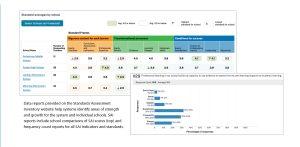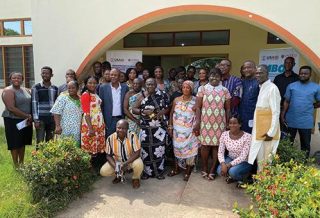FOCUS
Data collection tool drives professional learning improvements
By Tom Manning
Categories: Continuous improvement, Data, Evaluation & impactFebruary 2024
Collecting evidence of professional learning’s impact starts with assessing the current state of professional learning in any school or system. Measuring whether and how practices are impacting teaching and learning can shape the approaches that systems start, stop, and continue and increases the likelihood that professional learning strategies and programs achieve their intended outcomes.
For years, Michael Mauriello has used a valid and reliable method for assessing the current state of professional learning in Rockdale County Public Schools. Since 2015, the district of 15,000 students in Conyers, Georgia, has used Learning Forward’s Standards Assessment Inventory to measure alignment of Rockdale’s professional learning practices to Learning Forward’s Standards for Professional Learning.

“The Standards Assessment Inventory has been a reliable tool that provides our district and schools with a clear picture of our professional learning strengths and areas we need to focus on for improvement,” says Mauriello, director of professional learning in the district.
WHAT IS THE STANDARDS ASSESSMENT INVENTORY?
For nearly two decades, the Standards Assessment Inventory (SAI) has provided relevant, educator-level data helping systems of all kinds — states, districts, schools, provinces, and organizations — collect and track data about the professional learning their educators experience.
An online, confidential, valid, and reliable instrument administered to school-based instructional staff, the SAI asks teachers to provide their level of agreement with statements about the professional learning they experience. The SAI requires no familiarity with the Standards for Professional Learning to complete. SAI items, or indicators, are phrased as statements that align to a key concept within a standard, to which users measure their level of agreement on a five-point scale.
In Rockdale, measuring alignment to the standards has helped the district identify key focus areas and design professional learning around areas of growth identified by the SAI and aligned to school improvement goals. Through annual administration of the tool, they are able to track their progress on key indicators across time.
One of the recent focus areas was coaching, where the district focused on providing professional learning for instructional coaches. “Our SAI data indicated that our teachers needed additional job-embedded professional learning opportunities,” Mauriello said. “As a result of our SAI data and trends we saw in that data, we created a collaborative coaching model that focuses on providing our academic coaches with the skills they need to better support our teachers.”
Does this ring true? ‘’Professional learning in my school builds my capacity to implement my curriculum with integrity.’’ Learn how to gain a clearer picture on growth areas and design aligned PL using this data collection tool. 🔍🗺 Share on XNEW STANDARDS, NEW SAI
With the 2022 revision of the Standards for Professional Learning, Learning Forward revised the framework for the SAI to measure professional learning practices aligned to the new, evidence-based set of 11 standards.
Field-tested and validated by the American Institutes for Research, the current SAI provides data to help systems measure the alignment of their current professional learning practices to the standards; assess how well their professional learning meets the needs of their instructional staff; identify strengths and areas of focus in their professional learning; plan professional learning that gets results for teachers and students; and measure improvement over time.
One notable change in the 2022 version of the standards, as well as the SAI, is the inclusion of three equity-focused standards and SAI items aligned to those standards. While previous iterations of the standards had equity embedded within them, the 2022 revision includes three distinct equity standards: Equity Practices, Equity Drivers, and Equity Foundations.
Specifically highlighting the professional learning practices that lead to more equitable outcomes for teachers and students has helped school systems get a clearer picture of what equity actually looks like in the system.
In Rockdale, the administration of the revised SAI shed new light on the district’s professional learning practices around equity. “Our results on the equity standards on the revised SAI told us that our teachers need more opportunities to engage in conversations about how diverse cultures, identities, and lived experiences contribute to the learning environment,” Mauriello said. “The revised SAI’s Culture of Collaborative Inquiry standard and our results there also support the work our district is engaged in around collective teacher efficacy and continuous improvement.”
WHAT THE SAI PROVIDES
Systems that administer the SAI have access to a wide range of reports and tools that help them understand and analyze their data to make professional learning decisions.
Each system receives a series of data reports for each individual school or campus, as well as the system as a whole. These reports include average results for each standard and item within it, rated as “Skillful,” “Progressing,” or “Needs Attention” based on the average of responses.
Frequency counts provide more in-depth detail about how a school or system arrived at their averages, showing the total number of educators who gave each answer choice on each indicator. These reports help systems take the next step beyond average scores to drill down in specific areas.
Another set of reports disaggregates SAI data for each school. These are displayed within the SAI platform to allow districts to see side-by-side data comparisons of all schools and subsets of schools, providing an opportunity to see areas where individual or groups of schools show practices that could inform other schools and help best practices scale and spread.
For Mauriello, who leads administration of the SAI for Rockdale’s 21 schools each spring, the data help focus conversations at both the district and school levels on professional learning that maximizes resources and provides educators with support in critical improvement areas.
“In Rockdale County, we believe that professional learning is a partnership between the district and the schools. The district reports provide us with the big picture, and the school reports allow us to determine specific areas of need for each school,” he said.
Data-analysis tools and standards implementation resources are provided within the SAI platform for system coordinators, school leaders, and SAI takers who want to more deeply explore the standards.
For Rockdale, the new SAI provides ongoing opportunities to track continued impact of professional learning in the system with a focus on the revised standards. “We are excited about the revised standards and will continue to use the SAI as a tool to support our goal of continuous improvement in Rockdale County,” Mauriello said.
📚 Learn how the Standards Assessment Inventory (SAI) supported Georgia’s Rockdale County Public Schools 🍎 assessment and improvement of PL practices for better teaching and student outcomes. 📈#Education #HQPL #TheLearningPro Share on XSample SAI indicators
- Professional learning in my school builds my capacity to implement my curriculum with integrity.
- I have the opportunity to build discipline-specific content knowledge and expertise through professional learning at my school.
- The professional learning I experience at my school is relevant to my work.
- Professional learning at my school includes conversations about how cultural and historical barriers can impact student learning.
- Teachers in my school receive ongoing support (e.g., coaching, co-teaching, peer feedback) in various ways to improve teaching.
- My school system has structures and procedures that support collaborative educator learning.

Tom Manning is the senior vice president of virtual learning and leadership events for Learning Forward. He leads the strategy, management, and business development for the association’s consulting and technical assistance services. He advances Learning Forward’s vision by establishing and maintaining professional service partnerships with states, districts, and schools, and manages a cadre of more than 40 education consultants working across North America. He previously served as Learning Forward’s Associate Director of E-Learning, leading the design and implementation of the association’s online courses, webinars, and virtual learning communities. Prior to joining Learning Forward in 2009, he covered education as a reporter for the Houston Chronicle and Austin American-Statesman. He authored a chapter in the book Powerful Designs for Professional Learning (3rd ed.), and has been published in the Journal of Cases in Educational Leadership. Originally from Boston, Tom received a Bachelor of Arts in English and journalism from Texas Christian University.
Categories: Continuous improvement, Data, Evaluation & impact
Recent Issues
WHERE TECHNOLOGY CAN TAKE US
April 2024
Technology is both a topic and a tool for professional learning. This...
EVALUATING PROFESSIONAL LEARNING
February 2024
How do you know your professional learning is working? This issue digs...
TAKING THE NEXT STEP
December 2023
Professional learning can open up new roles and challenges and help...
REACHING ALL LEARNERS
October 2023
Both special education and general education teachers need support to help...










